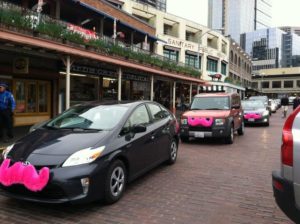Most people know the traditional four P’s of marketing: product, price, place, and promotion. Some may even be aware of other P’s such as positioning and people. But far less may be aware that for service businesses, there is a seventh P: physical evidence. Physical evidence is any kind of physical manifestation of a service. Unlike products, services do not have something you can taste or touch or view, so physical evidence is a tool marketers use to re-create that in a non-physical service. It can be as little as a receipt or the uniform of a company representative or a building’s design. It is used to leave a lasting impression on the person experiencing the service as well as potentially showcase that the person used the service to others.
An over-emphasis on removing the evidence
As entrepreneurs have started to build service businesses using the web and mobile devices, much of their efforts have been to replace the physical evidence of the old ways of doing things. Receipts? Don’t need those anymore. Customer service reps? Well, hopefully, no one ever needs to work with one, but if they do, they certainly won’t see what s/he is wearing. Building? There’s no need for them when everything can be accomplished by an app or a website. We’ll serve customers nowhere near our office and let employees work remotely. Punch cards? No one needs to carry those around now that we have apps that can store that information.
An over-emphasis on social promotion
This rush to eliminate all these reminders of the pre-online world has left a gap in many online companies’ marketing mix: any evidence that someone actually used the service that can remind them to come back or attract others. While every consumer web and mobile company seems to be falling over themselves trying to get you to tweet or create a Facebook update about your experience with them, which has been called the “exit through the gift shop” of the consumer web, few companies have tried to do the same in the physical world.
Word of mouth still happens offline
Many marketers have fooled themselves into thinking the atomic unit of much sought after word of mouth is a post about them on social media. The simple fact is that most word of mouth still happens via words, said through the, you guessed it, mouth. And that only happens offline. That realization is only half of it. Much word of mouth doesn’t come from people being so overjoyed by a service that they run and tell their friend about it. It happens because their friend sees them do something and asks them about it. For GrubHub, that might look like:
Clueless Friend: “So when are you going to order that sushi?”
Totally Hip You: “I already did. I just got texted that it will be here in 20 minutes.”
Still Clueless Friend: “Really? I didn’t see you make the call?”
Totally Hip You: “I didn’t. I used GrubHub.”
Starting To Get Clued-In Friend: “What’s GrubHub?”

What great physical evidence looks like
What physical evidence can help you do is generate more of those types of conversations in the real world. Great pieces of physical evidence do the following things:
1) Showcase the usage of the service in front of others, friends or not: When someone skips the line at an amusement park, they pass everyone in line on the way to the front, either advertising the service or making people ask how they did that and trying to find out
2) Become a showcase for the service even when not in use: Lyft’s pink mustaches stay on the fronts of cars even if no one is riding in that Lyft, or if the Lyft driver is just driving him or herself somewhere, leading people to ask what the mustaches mean.
3) Remind the original person who used the service to use it again: Punch cards get stored in wallets and remind and entice the person to make repeat visits just by seeing them or by there being a deal after a few more purchases.
Now, physical evidence is just one component of a successful marketing plan for a service. If it doesn’t match your positioning or your product, it will likely be ineffective. So, before you think about adding loud noises when someone opens your app (looking at you, Gilt), think about what the physical evidence will say about your product and if it will achieve one of those three goals listed above that is consistent with your company goals.